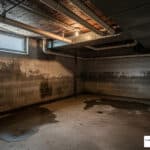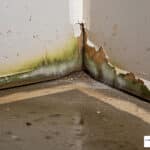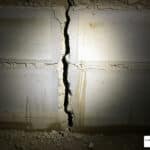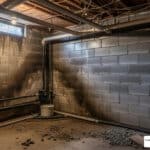That Musty Smell? Decoding Your Basement’s Cry for Help
Seeping basement walls are your home’s way of saying “Help!” – and in Maryland’s humid climate with our clay-heavy soil, nearly every basement faces this challenge at some point.
Quick Answer for Seeping Basement Walls:
Common Causes:
- Hydrostatic pressure from saturated soil pushing against walls
- Foundation cracks allowing water entry points
- Poor drainage directing water toward your foundation
- Cove joint failure where wall meets floor
Immediate Signs to Watch:
- White chalky residue (efflorescence) on walls
- Damp spots or water stains
- Musty odors and increased humidity
- Peeling paint or rust on stored items
Professional Solutions:
- Exterior drainage improvements (gutters, grading)
- Interior waterproofing systems with sump pumps
- Foundation crack repair and wall stabilization
- Comprehensive moisture control systems
Here’s what we’ve learned after 70+ years of fixing wet basements across Baltimore City, Baltimore County, and Harford County: that damp, musty smell isn’t just unpleasant – it’s your basement telling you that water is finding its way through your foundation walls.
Most homeowners think a little dampness is normal. It’s not. Water seepage through basement walls happens when excess groundwater builds up around your foundation, creating what we call hydrostatic pressure. Think of it like your house sitting in a shallow bowl that fills with water every time it rains.
The good news? Nearly every seeping basement wall issue can be fixed permanently with the right approach. The key is understanding why water is getting in before you try to stop it.
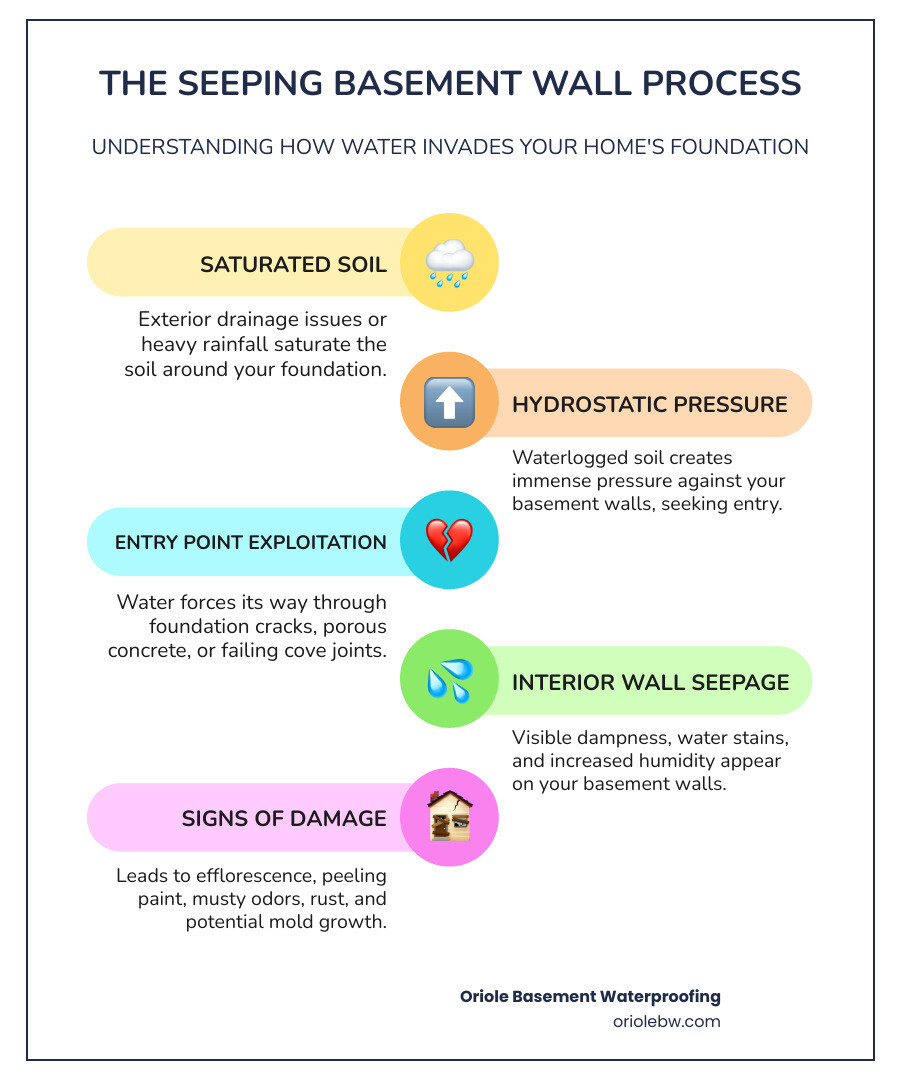
Why You Have Seeping Basement Walls: Uncovering the Root Causes
When we step into a basement with seeping basement walls, we’re witnessing a classic battle between your home and Mother Nature. After seven decades of fixing wet basements across Maryland, we’ve learned that water always wins – unless you understand what you’re up against and fight back with the right strategy.
The Science of Wet Walls: Hydrostatic Pressure and the “Clay Bowl Effect”
Picture this: you’re standing in your backyard after a heavy Maryland thunderstorm, and the ground feels like a soggy sponge under your feet. That water isn’t just sitting there looking innocent; it’s building up around your foundation like an invisible army, creating what we call hydrostatic pressure.
Think of it this way: when soil becomes completely saturated with water, it starts pushing against your basement walls with incredible force. It’s like having thousands of gallons of water in a swimming pool pressing against the sides, except this “pool” is all around your foundation. This relentless pressure doesn’t just knock politely; it forces moisture and water right through your concrete or block foundation walls.
Here in Baltimore City, Baltimore County, and Harford County, we deal with something that makes this problem even worse: the “clay bowl effect.” When your home was built, contractors dug a large hole for your foundation, then backfilled around it once the walls were up. Here’s the problem: that backfilled soil is much looser and more porous than the hard-packed, undisturbed soil further from your house.
This creates what looks like a giant bowl around your foundation that acts like a sponge, soaking up and holding way more water than the surrounding soil. With Maryland’s clay-heavy soil, this effect is particularly brutal. When this “bowl” fills with water after every rain, it becomes a permanent reservoir pressing against your foundation walls, making seeping basement walls almost inevitable without proper protection.
Common Culprits: Identifying Entry Points for Seeping Basement Walls
All that hydrostatic pressure we just talked about? It’s like having a fire hose pointed at your basement walls 24/7. But water still needs an opening to actually get inside. Over our decades in the business, we’ve seen the same entry points over and over again.
The biggest troublemaker is usually the cove joint – that’s where your basement floor meets your foundation walls. Even in well-built homes, this joint can develop gaps over time, creating a perfect highway for water to seep through. Without an interior drainage system to handle this moisture, you’re basically inviting water in for a permanent stay.
Foundation cracks are another major culprit, and they’re more common than most homeowners realize. While hairline cracks smaller than 1/8 inch are normal as concrete cures and settles, any crack can become a water entry point. Larger cracks often signal more serious foundation issues and should be addressed immediately. If you’re seeing cracks in your basement walls, our guide on Cracked Basement Maryland Causes Solutions can help you understand what you’re dealing with.
Porous concrete might sound like a contradiction, but concrete isn’t completely waterproof. Older concrete, or concrete that was poorly mixed during construction, can develop what we call “honeycombing”: small holes and weak spots that let water migrate slowly through the material itself.
Window wells below grade can become mini swimming pools if they’re not properly drained, creating direct pressure against your basement windows. Pipe penetrations where utilities enter your foundation are also vulnerable spots; if those seals fail or weren’t installed properly, water has a direct path inside.
Telltale Signs Your Seeping Basement Walls Need Attention
Your basement might not send you a text when there’s trouble, but it’s actually pretty chatty if you know what to look for. The sooner you catch these warning signs, the easier and less expensive the fix will be.
Efflorescence is probably the most common sign we see: that white, chalky residue that appears on concrete walls. Many homeowners think it’s mold, but it’s actually mineral deposits left behind when water evaporates. It’s like your wall’s way of saying, “Hey, water was here!”
Peeling or bubbling paint on basement walls is another dead giveaway. Moisture behind the paint causes it to lose its grip and start peeling away. Dark, damp spots and water stains might seem obvious, but they often appear in subtle patterns that tell a story about where water is coming from.
That classic musty basement smell isn’t just unpleasant; it’s usually the first sign of mold and mildew growth thriving in the moisture from seeping basement walls. A consistently humid basement, even with a dehumidifier running constantly, suggests you have an ongoing water intrusion problem.
Rust on appliances or stored items is another telltale sign. If your water heater, furnace, or stored tools are rusting prematurely, there’s too much moisture in your basement air.
The EPA points out that fixing household water leaks can save homeowners about 10 percent on their water bills, but that’s just the beginning when it comes to damage from seeping basement walls. You can learn more about the importance of addressing leaks promptly from their Fix a Leak Week information.
The bottom line? Ignoring these signs is like ignoring a small leak in your roof – it only gets worse, and the longer you wait, the more expensive the fix becomes.
From Problem to Permanent Fix: Professional Solutions for a Dry Basement
When you find seeping basement walls in your home, it’s natural to feel overwhelmed. But here’s the good news from our 70+ years serving Maryland families: every wet basement has a solution. The key is taking a comprehensive approach that addresses both the immediate symptoms and the underlying causes.
After decades of changing damp basements across Baltimore City, Baltimore County, and Harford County, we’ve learned that the most effective solutions work from the outside in, then create reliable backup systems on the inside. Think of it like treating a cold: you want to boost your immune system and have tissues ready just in case.
Why Exterior Drainage is Your First Line of Defense
Before we even step foot in your basement, our team always starts with a walk around your property. Why? Because water that pools near your foundation is the number one cause of seeping basement walls. If we can redirect that water before it ever reaches your foundation, we’ve already won half the battle.
Proper gutter maintenance and extensions are often the simplest yet most impactful solutions we recommend. Those clogged gutters aren’t just an eyesore; they’re dumping hundreds of gallons of water right next to your foundation every time it rains. We always tell homeowners to extend their downspouts at least 4-6 feet away from the house, though farther is even better. One customer in Baltimore County told us this simple change eliminated 90% of her basement moisture problems.
Yard grading is another game-changer that many homeowners overlook. If the soil around your home slopes toward your foundation instead of away from it, you’re essentially creating a funnel that directs every drop of rainwater straight to your basement walls. The ideal slope is about one inch per foot for the first several feet around your home – enough to guide water away naturally without creating an awkward slope in your yard.
These exterior improvements work by reducing the hydrostatic pressure that causes water to push through your foundation walls in the first place. It’s always easier to prevent a problem than to fix one after it’s already happening.
When Interior Waterproofing and Foundation Repair is Necessary
Sometimes exterior drainage isn’t enough, especially if your basement has been dealing with moisture for years or if structural issues are contributing to the problem. That’s when we bring in our comprehensive interior solutions: the heavy hitters that provide permanent protection even when Mother Nature throws her worst at your home.
Interior drainage systems paired with sump pumps are often the most effective long-term solution for persistent seeping basement walls. We install a perimeter drainage system along your basement floor that acts like a hidden highway for water. Any moisture that seeps through your walls or up through the floor gets collected and channeled directly to a sump pump, which automatically ejects it safely away from your foundation. It’s like having a dedicated bodyguard for your basement that never sleeps. You can explore the different waterproofing options and their benefits in our detailed guide to Basement Waterproofing System Types, Costs, Advantages.
Foundation crack repair and wall stabilization become essential when your seeping basement walls are accompanied by visible cracks or structural concerns. While hairline cracks smaller than 1/8 inch are normal, anything wider needs immediate attention. For walls that are bowing or showing signs of movement, we use carbon fiber straps – an incredibly strong solution that doesn’t require disruptive excavation. For more extensive structural issues, we handle everything from sill plate replacement and support beam replacement to floor joist replacement and subfloor replacement. Every major foundation repair includes consultation with structural engineers, ensuring your home’s stability for decades to come. Learn more about our comprehensive approach on our Foundation Repair MD page.
Vapor barriers complete the moisture control puzzle, especially in crawl spaces or particularly humid basements. These heavy-duty barriers cover walls and floors, creating an impermeable shield against moisture infiltration. While we focus on eliminating the source of moisture to prevent mold growth, if you already have significant mold issues, we work with Raven Mold for remediation – unless it’s a case where active water intrusion is feeding the mold problem, which we address as part of our waterproofing solution.
Securing Your Foundation for Good
Here’s what we’ve learned after seven decades of fixing wet basements: seeping basement walls aren’t just a nuisance; they’re a threat to your home’s value, your family’s health, and your peace of mind. That musty smell, those damp spots, that nagging worry every time it rains – none of that is normal, and none of it has to be permanent.
Our holistic approach means we don’t just patch the obvious problems. We assess your entire foundation system: drainage patterns, grading issues, humidity levels, and structural integrity. This comprehensive evaluation ensures you never have to chase the same problem again and again. We believe in getting it right the first time, which is why we back our work with transferable lifetime guarantees on all encapsulation and foundation repairs.
Every solution we implement is engineering-backed. For major foundation repairs, we partner with structural engineers to ensure long-term stability. Our certified technicians and project managers provide white-glove service from your initial inspection through post-job follow-up, keeping you informed every step of the way.
Don’t let seeping basement walls continue to compromise your home and your family’s comfort. We’re here to help you move from damp to dry, creating a strong, healthy foundation that will serve you for decades to come. Ready to reclaim your basement space? Get a permanent solution for your basement wall leak repair with Oriole Basement Waterproofing. Contact us today for a free inspection and let’s get started on changing your basement from a source of worry into a source of pride.

